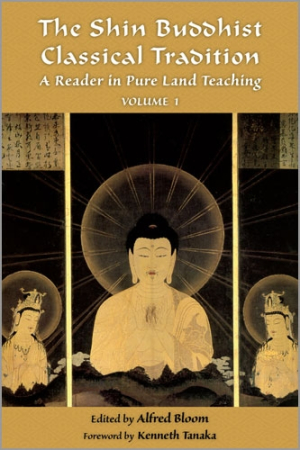The Shin Buddhist Classical Tradition
A Reader in Pure Land Teaching, Volume 1
This collection provides invaluable background to the complex and sometimes contradictory origins and teachings of Pure Land Buddhism.
The Shin Buddhist Classical Tradition: A Reader in Pure Land Teaching is a beautifully written and edited book that traces the evolution of Pure Land, a branch of Buddhism that dominates in much of East Asia. Spanning several hundred years and the writings of a multitude of Pure Land scholars and monks in India, China, and Japan, the 360 carefully footnoted readings in this attractively packaged book are an important addition to the library of literature about this fascinating and often misunderstood philosophy.
Alfred Bloom, the editor, has his PhD in Japanese Pure Land Buddhism and has written several highly acclaimed books on Shin Buddhism. His passionate commitment to the dissemination of the history of Pure Land Buddhism and its continuing relevance is palpably evident in the meticulous care taken in making this work highly readable and meaningful to scholars and laypeople.
Bloom’s twenty-page introduction provides an invaluable background to the complex and sometimes contradictory origins and teachings of Pure Land Buddhism.
The first section is titled “Foundational Sutras,” and opens with an extensive selection of early Buddhist teachings that outline and elaborate on the Pure Land, in particular, and many of the core tenets of Buddhism, in general.
The Amida Buddha and his forty-eight vows are central to Pure Land teachings and are included in their entirety. These lyrical vows elaborate on Pure Land, its paradisiacal qualities, and the potential for even the most sinful and least sophisticated to attain rebirth in Pure Land. The eighteenth and most cited vow in Pure Land texts, reads, “If, when I attain Buddhahood, sentient beings in the land of the ten quarters who sincerely and joyfully entrust themselves to me, desire to be born in my land, and call my name, even ten times, should not be born there, may I not attain perfect Enlightenment. Excluded, however, are those who commit the five gravest offences and abuse the right Dharma.”
Heavy on obscure symbolism, myth, and confusing references, yet rich with timeless teachings on compassion, human nature, and death, this section could stand alone as a primer on Pure Land philosophy and its continued relevance.
Section two, which encompasses nearly 300 of the readings, introduces the most influential writers in the lineage of Pure Land teachings as it spread through East Asia. Subsections with titles such as “Amida Buddha’s Primal Vows,” “Birth in the Pure Land,” and “Awakening of True Entrusting,” help the reader easily navigate through a myriad of teachers, countries, centuries, and translations, each with their unique style.
Profound wisdom and compassion emanate from every reading, and even when the writers are struggling with whether women, or those who say the name of Amida Buddha ten times, but without sufficient faith, are still eligible for birth in Pure Land, the context absolves them.
There is an accessible and necessary glossary at the end, as many core words that come up repeatedly, such as nembutsu, which means recitation of the Buddha’s name, and shinjin, faith in the vow or true entrusting, work better untranslated, as they contribute to the meditative flow of the narrative.
The Shin Buddhist Classical Tradition: A Reader in Pure Land Teaching is professionally packaged on every level, and would be an excellent addition to the lexicon of Buddhist titles in libraries and bookstores.
Reviewed by
Patty Sutherland
Disclosure: This article is not an endorsement, but a review. The publisher of this book provided free copies of the book and paid a small fee to have their book reviewed by a professional reviewer. Foreword Reviews and Clarion Reviews make no guarantee that the publisher will receive a positive review. Foreword Magazine, Inc. is disclosing this in accordance with the Federal Trade Commission’s 16 CFR, Part 255.

